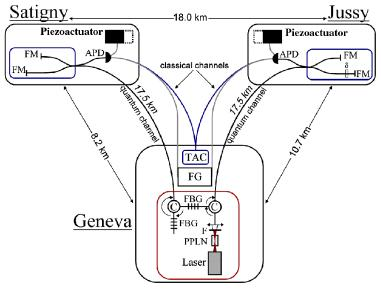In the Bell test, two photons from an entangled pair were sent from Geneva to Satigny and Jussy, two small towns located 18 km apart. This distance enabled the space-like separation necessary for finishing a quantum measurement in each town, which required a macroscopic mass to move. Detection of the mass’ movement was completed before information could have traveled between the two towns. Credit: D. Salart, et al.
In an attempt to rule out any kind of communication between entangled particles, physicists from the University of Geneva have sent two entangled photons traveling to different towns located 18 km apart – the longest distance for this type of quantum measurement. The distance enabled the physicists to completely finish performing their quantum measurements at each detector before any information could have time to travel between the two towns.
Many other experiments have observed quantum nonlocality – the “spooky interaction at a distance” that occurs between two entangled particles – and also known as a violation of Bell inequalities. But, as physicists Daniel Salart, et al., explain in a recent issue of Physical Review Letters, these Bell tests might not have gone far enough. If quantum measurements aren’t finished until after a mass has moved (as the team assumes here), then the Bell violations in previous tests might merely have been due to some type of classical communication between particles unknown to today’s physics.
In their experiment, the physicists sent pairs of entangled photons from Geneva through optical fibers leading to interferometers in two other Swiss towns: Satigny and Jussy, located 8.2 and 10.7 km away, respectively. The distance between the interferometers in Satigny and Jussy was 18 km.
With this large distance between the interferometers, the physicists could perform a more complete quantum measurement than has previously been done. Somewhat surprisingly, physicists have never decided exactly when a quantum measurement is finished (when the “collapse” occurs, if there is any).
Different interpretations of quantum mechanics lead to different answers. The most common view is that a quantum measurement is finished as soon as the photons are absorbed by detectors. Previous experiments have been set up to allow enough distance between particle detectors to prohibit communication under this view. But there are also other views of when the measurement is finished, including “when the result is secured in a classical system,” “when the information is in the environment,” or even that it is never over – a view that leads to the many worlds interpretation.
The Swiss team followed a view proposed independently by Penrose and Diosi, which assumes a connection between quantum measurements and gravity, and requires a macroscopic mass to be moved. In this view, the measurement takes more time than it does for a photon to be absorbed by a detector. The significance of the Swiss test is that it is the first “space-like separated” Bell test under the Penrose-Diosi assumption.
“There is quite a large community of physicists that speculates on possible connections between quantum gravity and the measurement problem,” coauthor Hugo Zbinden told PhysOrg.com. “The advantage of the Penrose-Diosi model is that it is testable using today's technology.”
In the physicists’ experiment, the detection of each photon by a single-photon detector triggers a voltage to a piezoelectric actuator. The actuator expands, which in turn causes a tiny gold-surfaced mirror to move. By measuring the mirror displacement, the researchers could confirm by the gravity-quantum connection that the quantum measurement had been successfully finished.
All of the steps – from photon detection to mirror movement – take about 7.1 microseconds, which is significantly less than the 60 microseconds it would take a photon to cover the 18 km between interferometers. So measurements made simultaneously at each of the interferometers could not be been influenced by anything traveling at – or even a few times more than – the speed of light.
“The significance of our experiment lies entirely in achieving space-like separation, even under the assumption that a quantum measurement is only finished after a macroscopic mass has moved, as in the Penrose-Diosi model,” Zbinden explained.
Altogether, the experiment serves to fill a loophole by ruling out any kind of communication between two entangled particles separated by a distance, provided the collapse happens only after a mass has moved. By spatially separating the entangled photons, the test once again confirms the nonlocal nature of quantum correlations.
More information: Salart, D.; Baas, A.; van Houwelingen, J. A. W.; Gisin, N.; and Zbinden, H. “Spacelike Separation in a Bell Test Assuming Gravitationally Induced Collapses.” Physical Review Letters 100, 220404 (2008).
Copyright 2008 PhysOrg.com.
All rights reserved. This material may not be published, broadcast, rewritten or redistributed in whole or part without the express written permission of PhysOrg.com.
























